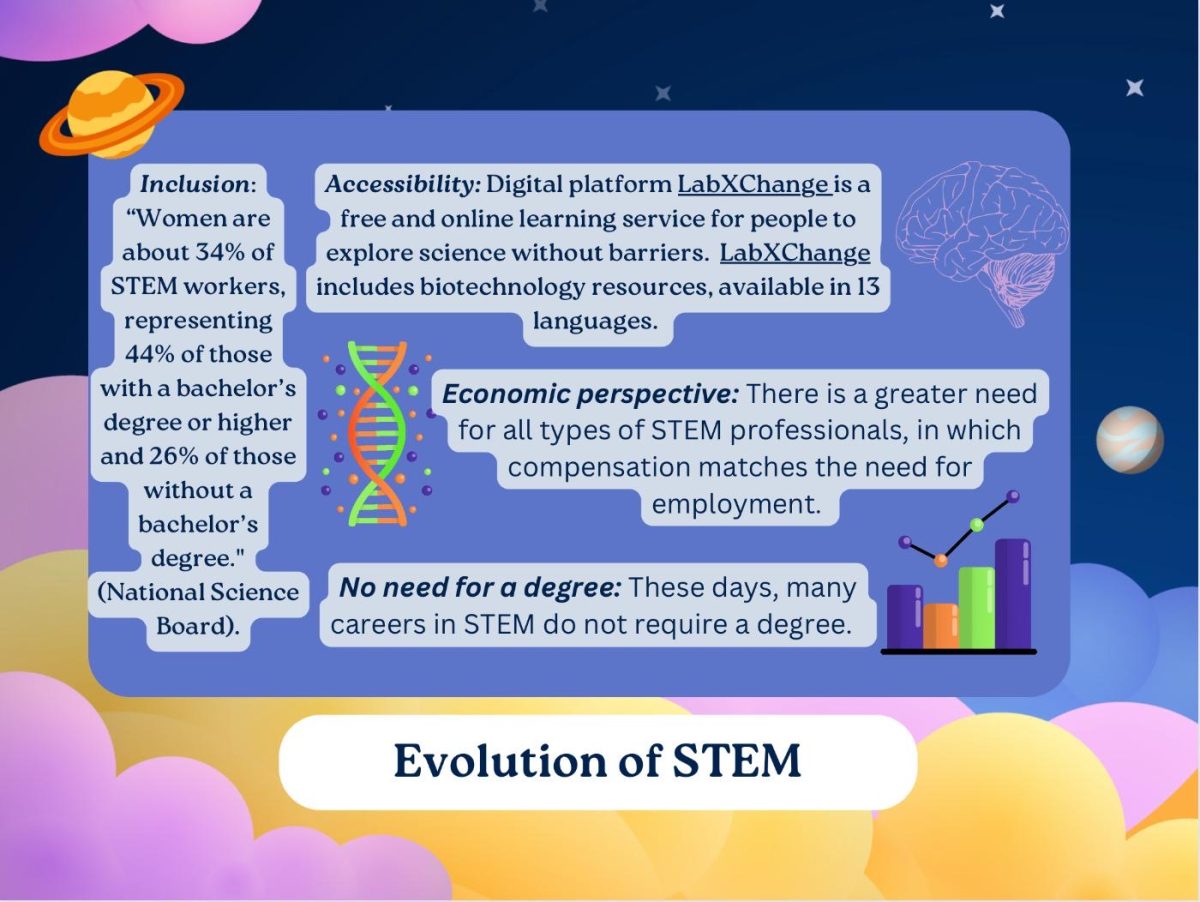
STEM Careers: Exploring Opportunities and Growth
The expansive STEM field provides aspiring students with a wide array of career options that can be tailored to their specific interests. As STEM has evolved over the past decades, the emphasis placed on exposing high schoolers to these different specialties has encouraged them to pursue their passions early on.
East, in particular, offers a variety of courses that provide students with beneficial initial experience in STEM. Such courses offer students the opportunity to challenge their current knowledge and introduce new ways of interpreting complex modern applications.
Toxicology, Introduction to Engineering, Neuroscience in Society, and Dynamics of Healthcare & Society are just a few examples of STEM electives at East. The diverse selection of such courses allows for the East environment to consist of a wide range of students with individual curiosities.
Mrs. Sassinsky currently teaches Biology, Marine Biology, and Forensics at East. She tries to prioritize introducing hands-on approaches to her classes to expose her students to real-world applications.
“We do a couple of things where we’re using engineering to create models of plankton. I try to use equipment as much as possible, like microscopes,” she notes.
The curriculums of these electives enable students to conceive their strengths and interests through interactive activities and projects. In addition, students develop crucial skills like problem-solving and collaboration along the way which aid them later on in their respective career paths.
Isabella Vascisin (’26), a student who takes Toxicology, says “[the course] is a great way to understand the basics of Toxicology and to learn just a little bit of what you’re going into if you pursue that career, especially with the chemistry of it. I think that I am much more interested in just science in general because of Toxicology.”
Nevertheless, recent trends suggest that a rising stress amongst high schoolers to generate flawless college transcripts often deters students from incorporating STEM courses in their schedule. Since STEM classes are relatively fast-paced, some students choose not to take these classes to avoid negatively impacting their GPA. Unfortunately, this has increasingly become the norm and limits students’ exposure to invaluable knowledge.
Mrs. Casey, a Physics and Scientific Principles of Nutrition teacher at East, hopes to dispel the misconception that STEM courses are inherently difficult. She constantly tries to remind her students that with time and effort, any STEM course is possible to succeed in.
“If you’re open-minded and willing to try and work and seek different methods of understanding, anybody can be successful in a STEM career or STEM field. There’s no special club where only certain people can do it,” she says.
With STEM playing a more pivotal role in society day by day, the prioritization of STEM education becomes increasingly important. East’s collection of STEM courses and electives introduces students to the abundance of STEM career options that they can pursue.
In the realm of Science, Technology, Engineering, and Mathematics, or better known as STEM, a concerning trend has emerged in terms of stem careers—there has been a notable decline in the number of students pursuing engineering degrees. This decline comes at a time where there is a high demand for engineers due to the imminent retirement of the Baby Boomer generation. Despite the increasing demand for engineering jobs, the enrollment in engineering programs across the world has seen a downward spiral.
Several factors have contributed to this steady decline. The challenging nature of engineering programs, the intense math and science requirements, and the overall rigidity of the curriculum discourage students from pursuing careers in STEM. These aspiring engineers are drawn to alternative paths such as computer science, where job opportunities are abundant and the study is more captivating with less overwhelming coursework. Moreover, employers oftentimes view newly graduated engineers as “cost-effective” hires, contributing to the idea that engineers are treated as commodities. The practice of offshoring entry-level engineering positions has become frequent and reduces employment opportunities for new engineers. STEM majors, particularly those in engineering, face unique challenges that heavily contribute to the declining enrollment. In contrast, non-STEM majors, like History or English majors, may be perceived as more accessible and flexible. Engineering programs, with their routine curricula, often lack the flexibility for individualized experiences which make alternative career paths more appealing to students who seek diverse educational paths.
The looming mass retirement of engineers from the Baby Boomer era, also known as the “Silver Tsunami,” increases the shortage of engineers. Additionally, the lack of representation by women and minorities in engineering further compounds the issue. Initiatives at the high school level are crucial in fostering interest in STEM programs and addressing the demographic imbalances in engineering fields. Countries like China have experienced a surge in engineering students, highlighting the global nature of the challenge. In the mid-1980’s, the U.S. had 80,000 engineering students. This number dropped to under 65,000 by the end of the 20th century. To maintain competitiveness in innovation, the U.S. must address this issue by further increasing interest at the high school level and providing hands-on learning experiences and more opportunities for those interested in or in entry-level STEM courses.
The declining enrollment in engineering programs is a complex issue influenced by various factors. Balancing the difficulty of the curriculum, exploring alternative paths, addressing offshoring practices, and promoting diversity are essential steps in revitalizing interest in STEM careers. As the world evolves, nurturing the next generation of engineers is crucial for sustaining innovation and competitiveness in the global landscape. As global technology continues to grow, an influx of collaborators are required in order to move forward as a community.






